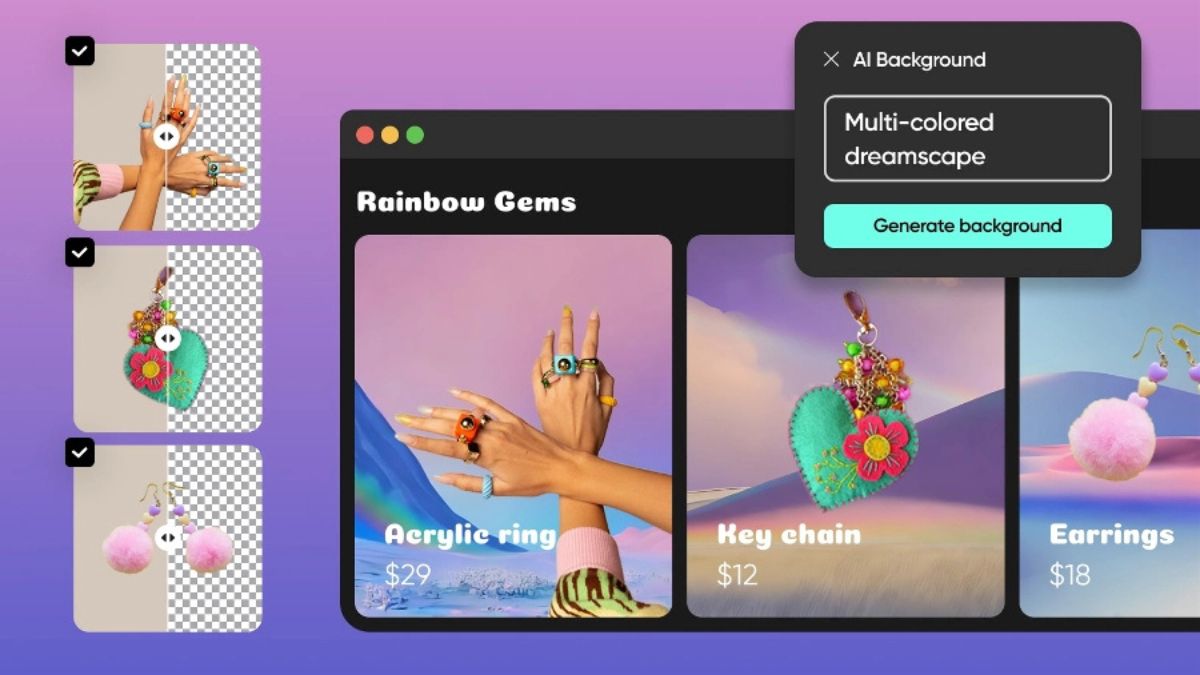TECHNOLOGY
Image Editing API: Revolutionizing Digital Creativity and Development

In today’s visually-driven world, the demand for high-quality images and creative content is ever-increasing. Whether it’s for e-commerce, social media, design projects, or marketing campaigns, businesses and developers need powerful tools to manipulate and edit images. This is where Image Editing APIs come into play. These Application Programming Interfaces (APIs) allow developers to seamlessly integrate sophisticated image-editing capabilities into their applications, websites, and services.
An Image Editing API can perform a wide range of operations, from simple enhancements like cropping, resizing, and rotating, to more complex functions like applying filters, removing backgrounds, or performing image recognition tasks. The benefits of using an Image Editing API extend to developers, businesses, and consumers alike, as these tools enhance user experience, streamline workflows, and empower innovation.
In this article, we will explore the concept of an Image Editing API, its use cases, key features, and some of the best APIs available today. Whether you’re a developer looking to integrate image editing functionality into your app or a business looking to optimize your content creation, this guide will provide you with valuable insights.
What is an Image Editing API?
An Image Editing API is a set of protocols and tools that allows developers to incorporate image editing functionality into their applications or websites. These APIs typically expose a variety of image manipulation and processing functions through simple HTTP requests, enabling easy integration with little or no need for advanced knowledge of image processing techniques.
By using an Image Editing API, developers can offload the heavy lifting of image manipulation to external servers, saving on development time and resources. This API essentially allows users to upload, edit, and download images with ease, while accessing a broad range of features that can transform an image in just a few clicks.
Common Image Editing Features and Capabilities
Image Editing APIs offer a broad spectrum of editing functionalities, which can be categorized as follows:
Basic Image Enhancements
Resizing: Change the dimensions of an image, often preserving the aspect ratio.
Cropping: Remove unwanted parts of the image by cutting it to a specified area.
Rotating: Rotate an image by a specified angle (e.g., 90°, 180°).
Flipping: Flip the image horizontally or vertically.
Filters and Effects
Grayscale: Convert the image to black and white.
Sepia: Apply a vintage sepia tone to give the image an antique look.
Blur: Add a blur effect to the image, useful for softening or creating background effects.
Contrast and Brightness Adjustment: Modify the brightness or contrast levels for better image clarity.
Advanced Editing
Background Removal: Automatically detect and remove the background from images, making them transparent.
Image Retouching: Remove imperfections such as blemishes, wrinkles, or unwanted objects.
Text Overlay: Add text, captions, or labels to an image with customizable fonts, colors, and styles.
Object Detection: Detect and highlight specific objects within an image using machine learning algorithms.
Watermarking: Apply watermarks to images for copyright protection.
Special Effects and Enhancements
Sticker and Emoji Integration: Place fun stickers or emojis on the image.
Image Stitching: Combine multiple images into one seamless panorama.
Deep Learning Features: AI-powered features such as style transfer (turning images into artwork like Van Gogh paintings) or facial recognition.
File Conversion
Format Conversion: Convert images between different formats (JPEG, PNG, GIF, TIFF, BMP, etc.).
Compression: Reduce the file size of an image without significant loss of quality to optimize performance.
Why Use an Image Editing API?
Time and Cost Efficiency
Developing and maintaining image-editing features in-house can be a resource-intensive and costly process. By integrating a third-party Image Editing API, developers can save considerable time and money. The API provides ready-made functions, so there’s no need to build complex algorithms from scratch.
Scalability
Image Editing APIs are built to handle large volumes of image requests efficiently. Whether you’re processing hundreds or thousands of images per day, APIs are designed to scale with the demand, ensuring a seamless user experience even during peak usage.
Improved User Experience
A seamless image-editing experience can significantly enhance the user journey, whether it’s a simple task like resizing images or complex processes like applying advanced filters. APIs make it easy to provide rich, interactive experiences on your platform without extensive development effort.
Cross-Platform Compatibility
Many Image Editing APIs are designed to work across different platforms, including web, mobile, and desktop applications. This cross-platform functionality ensures that users can access the same editing features on various devices, leading to greater flexibility.
AI and Automation
Some advanced Image Editing APIs come with built-in artificial intelligence capabilities that can automate tasks such as background removal, facial recognition, and object detection. This helps reduce manual effort, speed up workflows, and increase productivity.
Use Cases for Image Editing APIs
The applications of Image Editing APIs span across a variety of industries, including e-commerce, social media, photography, graphic design, and even healthcare. Some common use cases include:
E-commerce
E-commerce platforms rely heavily on high-quality product images to attract customers. An Image Editing API can help enhance product photos, remove backgrounds, and ensure consistency in product presentation. APIs can also automatically resize images to fit various display sizes, improving load times and performance.
Social Media
Social media platforms and content creators often need to quickly enhance images before posting. An Image Editing API can help users add filters, crop images, or overlay text and graphics. This can improve the visual appeal of social media posts, ultimately driving engagement.
Graphic Design
Designers often require image-editing tools for creating visual content such as banners, flyers, and infographics. APIs can help automate repetitive tasks like resizing, layering, and text addition, freeing up more time for creative tasks.
Healthcare
In the healthcare industry, Image Editing APIs are useful for processing medical images, such as scans and X-rays. APIs can help enhance image clarity, highlight certain areas, and convert files to different formats to be used across multiple platforms.
Real Estate
Real estate websites frequently rely on high-quality images to showcase properties. Using Image Editing APIs, agencies can optimize photos by correcting brightness, cropping, and adding logos or watermarks to images before listing properties online.
Top Image Editing APIs
There are numerous Image Editing APIs available today, each offering unique features and functionalities. Here are some of the best ones to consider:
Cloudinary
Cloudinary is one of the most popular and robust image management platforms. It offers a wide range of image-editing features, including cropping, resizing, and applying filters. Cloudinary also supports advanced features like background removal, facial recognition, and AI-driven enhancements. It integrates easily with a variety of web and mobile applications.
Adobe Photoshop API
Adobe’s Photoshop API brings the power of Adobe’s flagship software to web and mobile apps. This API allows developers to integrate image editing tools such as layer manipulation, retouching, resizing, and advanced effects. Adobe’s image-processing capabilities are trusted by professionals in the design and creative industries.
Fotor
Fotor offers an API that provides a rich set of image editing tools, including basic enhancements, filters, effects, and collage creation. It also features an AI-powered background remover and facial recognition tools, making it ideal for applications in photography and social media.
Remove.bg
Remove.bg is a specialized API focused on automatic background removal. It uses advanced AI to separate the foreground from the background of images. This API is particularly useful for e-commerce platforms, where product images need to have clean, professional-looking backgrounds.
Imgix
Imgix offers a powerful image processing API that includes capabilities like resizing, cropping, applying effects, and real-time optimization for web and mobile use. Imgix also provides features such as automatic color correction and image enhancement, making it a versatile choice for content creators and developers.
Pixlr
Pixlr offers both an editor and an API, providing tools for advanced image editing and design. The API includes image manipulation features like resizing, cropping, applying filters, and more. Pixlr is a great option for those looking for a more design-focused image-editing tool.
Best Practices for Using an Image Editing API
While Image Editing APIs can provide a wealth of functionality, it’s important to follow best practices to ensure smooth integration and optimal performance:
Choose the Right API: Choose an API that matches your specific use case and requirements. Consider factors such as the range of features, pricing, scalability, and integration ease.
Optimize for Performance: Image manipulation can be resource-intensive. Use compression and caching strategies to optimize image processing and minimize loading times for users.
Test Across Devices: Ensure that the API works well across all platforms, including mobile and desktop, to provide a consistent user experience.
Handle Edge Cases: Some images may be challenging to process (e.g., very low resolution or complex objects). Implement error handling and fallback mechanisms to deal with such edge cases.
Monitor Usage: Keep track of API usage and performance to ensure you’re within the service’s limits. Some APIs have usage-based pricing models, so monitoring can help control costs.
Conclusion
The rise of Image Editing APIs has dramatically simplified the process of integrating image manipulation tools into websites, apps, and services. With features ranging from basic enhancements to advanced AI-driven functions, these APIs enable developers to quickly deliver powerful image-editing capabilities to users without reinventing the wheel.
By leveraging the right Image Editing API, businesses can improve user engagement, streamline workflows, and offer creative freedom. Whether it’s for social media, e-commerce, or design, Image Editing APIs are transforming the way images are handled and manipulated across industries. As the demand for visually appealing content continues to grow, these APIs will continue to evolve, offering even more advanced features and capabilities to meet the needs of developers and users alike.
TECHNOLOGY
Crafting Success: The Dynamic World of Programmatic Display Advertising

Introduction to Programmatic Display Advertising
Programmatic display advertising marks a quantum leap in how brands communicate with audiences amid the digital age’s hustle and bustle. This automated approach to ad buying places a significant emphasis on efficiency and precision, enabling advertisers to refine how ads are purchased and delivered significantly. At their core, programmatic solutions simplify the buying, placement, and optimization of media inventory, allowing for more strategic, creative, and impactful campaigns.
The shift to programmatic display advertising emerged due to evolving consumer behavior and technological advancements. Manual ad-buying processes became archaic and inefficient, with audiences distributed across myriad digital platforms. Programmatic solutions address these concerns by automating processes that once required significant manual effort, offering advertisers a powerful tool to handle the complexities of today’s digital advertising landscape efficiently.
The Mechanics of Real-Time Bidding
Real-time bidding (RTB) is integral to the programmatic advertising framework. This process resembles a stock market for ad space, where bids for inventory happen in mere milliseconds. Through RTB, advertisers leverage audience data to make instantaneous decisions about which ads to bid for and at what price. This fosters an environment where relevance supersedes conventional broad strokes in advertising placement. As a result, marketing messages are delivered with unmatched timeliness and relevance, connecting with the right audience at the perfect moment. RTB is emerging as retail media’s next frontier, underscoring its growing importance in delivering targeted, high-impact campaigns.
The significance of real-time bidding cannot be overstated. By allowing advertisers to adjust bids dynamically based on real-world data, RTB ensures efficient ad spending and maximizes the potential for engagement. This swift flexibility gives brands a distinct advantage in capturing attention and driving conversions in an endlessly noisy online environment.
Benefits of Programmatic Display Advertising
Programmatic display advertising offers numerous advantages that are transforming the advertising landscape. It enables brands to extend their reach more effectively and efficiently. By using automated systems, marketers can streamline operations and reduce costs, ensuring a greater return on investment.
One of the standout benefits is the enhanced targeting capability. Advertisers can specify target audiences by considering demographics, online activities, and buying history. Such granularity allows tailored messaging that resonates more deeply with recipients, boosting engagement and conversion rates. Through programmatic advertising, brands can converse directly with consumers in ways that matter, making their marketing efforts more impactful.
Effective Strategies for Advertisers
Employing effective strategies within programmatic display advertising is crucial for maximizing impact. Understanding audience preferences is the first step in crafting compelling advertising. Leveraging data analytics allows advertisers to create targeted marketing messages. This data-driven foundation lets brands anticipate needs and deliver content that aligns with consumer interests and behaviors.
Innovation in creative approaches plays an equally important role. Captivating visuals combined with dynamic content keep audiences engaged. Advanced targeting, such as retargeting strategies, ensures the continuation of brand engagement, turning fleeting interactions into lasting relationships. Today’s digital landscape requires advertisers to keep content fresh and relevant, capturing attention in moments that matter.
Potential Challenges and Solutions
Despite its myriad benefits, programmatic advertising is not without its challenges. Transparency within the ad delivery process remains a concern for many advertisers. Adopting systems that enhance visibility into placement and pricing can alleviate this issue and bolster trust and confidence in programmatic campaigns.
Fraud is another concern that plagues digital advertising. Ads not reaching their intended audience due to fake impressions or fraudulent activity can be detrimental. Advertisers rely on sophisticated fraud detection technologies and choose platforms with robust anti-fraud measures to combat this. Furthermore, vigilance around compliance and privacy laws is essential as these regulations continue to evolve, impacting how brands engage with consumers online.
The Future of Programmatic Advertising
Looking ahead, programmatic advertising promises continued growth and innovation. Integrating artificial intelligence (AI) and machine learning will refine ad targeting and personalization. By learning from past interactions, machines can deliver hyper-relevant content that meets consumer expectations.
The marketing landscape is poised for transformation, driven by new technologies and more sophisticated methodologies. Industry leaders suggest that as programmatic tactics mature, advertisers will embrace opportunities to create even more personalized advertising experiences, continuously refining their techniques for maximum effectiveness. Articles exploring programmatic advertising highlight algorithms’ ongoing importance in shaping this dynamic industry’s direction.
Key Considerations for Success
Finding the proper equilibrium between automation and human supervision is essential for ongoing success in programmatic display advertising. Even though automated systems manage the bulk of the workload, strategic contributions from marketing teams guarantee alignment with broader business goals. It is essential to select the appropriate technology partners and platforms as they directly influence campaign success and brand image.
Monitoring performance metrics and integrating feedback loops are imperative to optimize results. Every campaign provides insights to enhance the next, allowing brands to fine-tune strategies to align with changing market dynamics and consumer preferences. Embracing an iterative approach is key to thriving in public-facing digital spaces.
Conclusion: Harnessing the Power of Programmatic Advertising
In sum, programmatic display advertising represents a revolutionary shift in brand-to-consumer communication. By harnessing the power of automation and data-driven strategies, advertisers can wield technology with precision and purpose. Continuous adaptation to the evolving advertising landscape will ensure that brands remain connected with their audiences in meaningful ways. As highlighted in Forbes, staying on top of emerging trends is imperative. With programmatic advertising as a mainstay, the future of digital marketing shines brightly, offering endless possibilities for innovation and success.
TECHNOLOGY
Skypessä: Innovative Communication Platform

Effective communication has always been a pillar of success, whether in business, education, or personal connections. With the digital age in full swing, innovative platforms continue to reshape how we connect, collaborate, and communicate. Enter Skypessä, the next-generation communication tool that’s designed to meet the evolving needs of modern users.
Whether you’re a professional seeking seamless business communication, a student collaborating on group projects, or simply someone looking to stay connected with loved ones, Skypessä promises to redefine your experience.
This blog dives into Skypessä’s innovative features, how it stands out in the crowded digital communication space, and why it’s the platform you need to enhance your connections.
What is Skypessä?
At its core, Skypessä is a cutting-edge communication platform offering a comprehensive suite of tools tailored to meet the needs of a diverse user base. Combining state-of-the-art technology with a user-friendly interface, Skypessä bridges gaps in communication by allowing its users to interact seamlessly across various channels.
With an emphasis on interoperability and innovative features, Skypessä is more than just a tool for connecting people; it’s a platform built to enrich interactions, foster collaboration, and empower its users.
Standout Features of Skypessä
Skypessä leverages modern technology to provide standout features, making it a preferred choice for individuals and businesses alike. Here’s a look at its key functionalities:
- Unified Communication Channels
Chat, voice calls, video meetings, and collaboration tools are all housed under one roof. Skypessä eliminates the need to switch between multiple apps, making workflows smoother and more efficient.
- Crystal Clear Video and Voice
Skypessä uses state-of-the-art audio and video technologies to deliver unmatched call clarity. Whether it’s a one-on-one video chat or a large webinar, you can trust Skypessä to keep the session crisp and lag-free.
- AI-Driven Transcription and Translation
Language is no longer a barrier with Skypessä’s real-time transcription and translation features. Participants from around the world can communicate effortlessly, picking up conversations in their native languages.
- Smart Scheduling with Calendar Integration
Forget the headache of scheduling nightmares. Skypessä integrates with popular calendars like Google and Outlook to streamline appointment setting and meeting reminders.
- Security You Can Trust
Built with enterprise-grade security, Skypessä ensures that your conversations, data, and meetings remain safe. It employs end-to-end encryption for private communication and complies with stringent global data protection standards.
- Customizable User Experience
From themes and layouts to workflows and integrations, Skypessä offers a high level of customization, allowing users to tailor the platform to suit their specific needs and preferences.
Why Skypessä Stands Out in the Crowd
The era of digital communication is filled with options like Zoom, Microsoft Teams, and Slack. However, Skypessä sets itself apart in notable ways:
1. Purpose-Driven Innovation
Unlike platforms that tack on features without coherence, Skypessä builds every functionality with purpose. Its tools are designed to answer real challenges faced by modern users, from language barriers to collaboration inefficiencies.
2. Accessibility for All
Skypessä prioritizes accessibility, ensuring its platform is intuitive for users of all skill levels. Whether you’re a tech-savvy professional or someone simply looking to make a quick call, Skypessä’s intuitive design accommodates all.
3. Adaptable for Businesses and Individuals
The platform transitions seamlessly between personal and professional use cases. Grow your small business with team collaboration tools, or catch up with family using group video calls. Skypessä caters to all needs.
4. Community-Driven Upgrades
Skypessä’s thrives on feedback. Regular updates and improvements are based on user demands, ensuring that the platform evolves consistently to meet user expectations.
How to Get Started with Skypessä
Joining Skypessä’s is quick and easy. Here’s how you can set up and start reaping the benefits of this innovative platform:
- Sign Up for Free
Visit the Skypessä’s website and create your account in minutes. The intuitive onboarding process ensures no technical barriers.
- Download the App
Skypessä’s is available across multiple platforms, including desktop (Windows, macOS) and mobile (iOS & Android). For businesses, it also offers browser-based solutions for quick access.
- Explore the Features
Once you’re in, take a tour of its key features and tools. Skypessä’s offers tutorials to walk you through features like smart scheduling, transcription, and group setups.
- Upgrade for More Features
While Skypessä’s free version is robust, consider upgrading to its premium plans for advanced features like larger meeting capacities, custom branding, and premium support.
Building a Community Through Skypessä
Skypessä’s isn’t just a communication tool; it’s a platform that believes in fostering connections and community. With features designed to bring people closer, it sets the stage for deeper collaboration and meaningful interactions.
The platform also offers a thriving user community, where you can engage, share ideas, and learn how others are using Skypessä’s in creative ways.
Why Skypessä is the Future of Communication
As businesses and individuals look for smarter, seamless ways to connect, platforms like Skypessä will lead the charge. By combining innovation with accessibility and bridging communication gaps, Skypessä stands as a true game-changer in the realm of digital communication.
Whether you’re running a dynamic team project, conducting global meetings, or just trying to stay in touch, Skypessä’s offers a reliable, forward-thinking solution.
Explore Skypessä Today
Want to see how Skypessä’s can transform your communications? Don’t wait. Sign up today for free and explore the platform that promises to revolutionize the way we interact.
TECHNOLOGY
VF1H-1 50MHz: Revolutionizing Amateur Radio Communication

Prepare to take your amateur radio skills to the next level with the VF1H-1 50MHz! This state-of-the-art apparatus is more than simply an accessory; it is a revolutionary piece of gear that will transform the way you interact with other operators. Envision communications with a stunning frequency range and pristine clarity, ushering in a new era of inquiry and conversation. Everyone in the amateur world may benefit from this technological advancement, whether they are seasoned pros or just starting out.
Let’s dive into what makes the VF1H-1 stand out in a crowded market and why it’s quickly becoming a favorite among amateurs everywhere.
What is VF1H-1 50 MHz?
One cutting-edge piece of amateur radio gear that has been developed to improve communication possibilities is the VF1H-1 50MHz. Its special frequency range, which runs on the 50 MHz band, opens up a universe of possibilities for its customers.
Effortless operation and cutting-edge technology come together in one gadget. Both amateurs and experts will appreciate how easy it is to carry and use thanks to its small size.
The VF1H-1 stands out due to its strong output and the variety of modulation modes it offers. That means your signals will be more distinct and your connections will be more stable as you communicate.
Your amateur radio skills will be taken to the next level with this equipment, whether you’re chatting with friends or competing in contests. The ability to connect successfully in a wide range of settings is more important than merely transmitting.
What sets the VF1H-1 apart from other amateur radio equipment?
When compared to other amateur radio gear, the VF1H-1 50MHz stands out thanks to its wide frequency range. Operators are able to investigate multiple communication channels using the VF1H-1, as it covers a large spectrum, unlike many radios that specialize in specific bands.
One important distinction is its power output. Thanks to its sturdy construction, you can crank up the power without compromising sound quality or efficiency. With this, fans will be able to receive signals with more clarity and a wider range.
What really sets this concept apart is its adaptability. Its versatility in supporting numerous forms of modulation allows it to easily adapt to a wide range of user preferences and situations. It seamlessly adjusts to your preferred frequency, be it SSB or FM.
Its attractiveness is further enhanced by its user-friendly features. The user-friendly design makes it suitable for operators of all experience levels, from complete novices to seasoned pros.
The Benefits of using the VF1H-1 for Amateur Radio Communication
Superior clarity is provided by the VF1H-1 50MHz, allowing for crystal-clear transmission across long distances. Ham operators rely on good signals for their exchanges; therefore, this dependability is vital for them.
Its user-friendly modulation types make switching modes a breeze. The VF1H-1 seamlessly adjusts to your preferences, be it FM, SSB, or CW.
It improves transmission strength with its remarkable power output. Improved signal penetration via different settings and a greater reach are the results.
The convenience of portability is yet another major perk. In the event of an emergency or during field operations, its small size and light weight make it easy to transport.
Both inexperienced and seasoned operators will find the controls to be intuitive and easy to use. Confusion at crucial moments of communication is eliminated by the straightforward UI.
Expert Reviews and Testimonials of the VF1H-1
Amateur radio amateurs and professionals have both taken notice of the VF1H-1 50MHz. When it comes to communication, many people say it’s very clear and dependable.
With a direct line to the globe,” one veteran operator said. Its audio is second to none. Here we can see how the gadget improves the user experience across different bands.
Its adaptability to various operating situations was emphasized by another reviewer, who also praised its diverse modulation kinds. People love this feature since it can be used for both regular conversations and emergency messages.
Also, reviews on its power output capabilities are pouring in. Proof of the VF1H-1’s robustness is the strong performance recorded by operators, even in demanding conditions.
Members of the community clearly have faith in this gear for all of their networking requirements, as the feedback keeps rolling in. People that use the VF1H-1 on a regular basis tend to be more and more enthusiastic about it.
How to Get Started with the VF1H-1 50MHz
The VF1H-1 50MHz is a thrilling instrument to learn how to use. Make sure you can legally use amateur radio frequencies before you do anything else. In order to ensure compliance and safety, this step is crucial.
The next step is to take your VF1H-1 out of its packaging and learn how to use it. You can connect the antennas and power sources according to the instructions in the user manual.
After assembly is complete, select a frequency range within the 50 MHz band that corresponds to your communication requirements. Determine which of the device’s numerous modulation kinds is most appropriate by playing around with them.
If you need help or advice from more seasoned users, you may always listen in on amateur radio groups or join an internet forum. When it comes to getting the most out of your machinery, they can give you some great advice.
Perfect comes with practice! Discover everything that this flexible transceiver can do by starting to make connections and playing around with the settings.
Application and Usage Scenarios for the VF1H-1
The VF1H-1 50MHz is perfect for a wide range of amateur radio uses due to its adaptability.
In the event of an emergency, operators can readily participate in local communications. Transmissions are crystal clear in situations where every second matters because of its dependable frequency range and power output.
The VF1H-1 adds fun, portable operation to the hobbyist’s toolbox. The small size and lightweight construction make it ideal for usage in out-of-the-way places, whether you’re camping or trekking.
Its sophisticated features are great for contesting fans. Participants are able to engage with others in a variety of settings, thanks to the numerous modulation kinds, which improves the competitive experience.
Another important factor is the dissemination of information. The VF1H-1 is a popular choice for clubs’ training sessions and seminars that teach novices amateur radio technology.
By utilizing this equipment in the classroom, educators may engage students in hands-on learning activities pertaining to radio transmission procedures, which piques their interest in STEM subjects and promotes scientific and communication concepts.
The Future of Amateur Radio
Numerous exciting opportunities are ahead for amateur radio in the years to come. New and improved means of communication are always on the horizon, thanks to technological progress.
Digital mode and software-defined radio advancements should provide operators with more flexible and clear signals. The VF1H-1 50MHz is a game-changer because of its many useful features.
Artificial intelligence (AI) integration may also provide ham operators with new capabilities. Picture analytics that evaluate band conditions in real-time and assist in optimizing communications accordingly.
Involvement of the community will also be vital. The future of amateur radio is being shaped by the new ideas and energy that more and more young people are bringing to the hobby.
Looking ahead, innovative uses in remote operations and emergency response might be possible if operators throughout the world work together. Being a member of this pastime at this moment is thrilling since the terrain is always changing.
Conclusion
If you’re an amateur radio operator, the VF1H-1 50MHz is more than simply gear; it’s a communication revolution in a box. It improves the way enthusiasts communicate with its top-notch features.
Envision being able to effortlessly experiment with different forms of modulation or discover new frequencies. Clear and dependable long-distance talks are now within reach, thanks to the adaptability and power output.
-

 BLOG1 year ago
BLOG1 year agoATFBooru: A Hub for Animated Art and Community
-

 CONSTRUCTION12 months ago
CONSTRUCTION12 months agoBuilding a Home Gym in Your Basement (7 Key Renovation Tips)
-

 BLOG1 year ago
BLOG1 year agoFictionmania: A Deep Dive into the World of Transformative Stories
-

 GAMES1 year ago
GAMES1 year agoSnow Rider 3D: Unblocked Tips and Tricks for Gamers
-

 BLOG11 months ago
BLOG11 months agoGIFHQ: A Comprehensive Guide
-

 BLOG1 year ago
BLOG1 year agoVincent herbert new wife: A Detailed Overview
-

 BUSINESS1 year ago
BUSINESS1 year agoInvestiit.com Tips: A Comprehensive Guide for Smart Investing
-

 BLOG1 year ago
BLOG1 year agoWNFLB: A Deep Dive into Its Impact on Women’s Sports Introduction to the WNFLB
